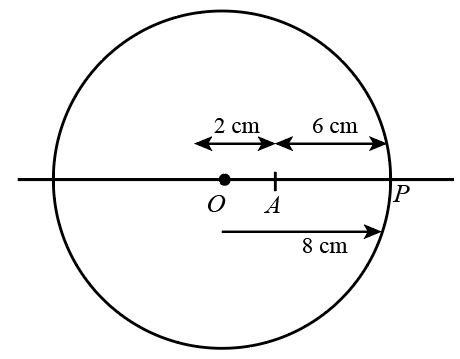
A point object is enclosed in a glass sphere of 8 cm radius. It is situated 2 cm from centre and is viewed from the side to which it is nearer. Where will it appear to be if μ of glass = 1.5?
A. 6 cm from the centre.
B. 4 cm from the nearer surface.
C.16/3 cm from the nearer surface.
D. 11/3 cm from the centre.
Answer
574.8k+ views
Hint: When light travels from one medium to the other medium, it changes its path due to the difference of densities in the two mediums. A convention term called refractive index relates the refraction of light from one medium to the other medium.
Complete step by step answer:
Refer to the figure given below.

According to the sign convention the data are given as:
The refractive index of the glass is ${\mu _1} = 1.5$.
The refractive index of the air is ${\mu _2} = 1$.
The radius of the sphere is $R = - 8\;{\rm{cm}}$.
The object distance is $u = - 6\;{\rm{cm}}$
The object is situated at point A which is 6cm from the nearby surface point P.
Express the relation for spherical lenses.
$\dfrac{{{\mu _2}}}{v} - \dfrac{{{\mu _1}}}{u} = \dfrac{{{\mu _2} - {\mu _1}}}{R}$
Here, v is the distance of image from the surface point P.
Substitute ${\mu _1} = 1.5$, ${\mu _2} = 1$, $R = - 8\;{\rm{cm}}$, $u = - 6\;{\rm{cm}}$ to find the value of v.
\[\begin{array}{l}
\dfrac{1}{v} - \dfrac{{1.5}}{{6\;{\rm{cm}}}} = \dfrac{{1 - 1.5}}{{ - 8\,{\rm{cm}}}}\\
v = - \dfrac{{16}}{3}\;{\rm{cm}}
\end{array}\]
Note:
he definition of the refractive index can also be told as the ratio of the speed of light in vacuum to the speed of light in another medium may be water, glass etc. and it is represented as:
$\mu = \dfrac{c}{v}$
Here, $\mu $ is the refractive index, c is the speed of light in vacuum and v is the speed of light in the medium.
Complete step by step answer:
Refer to the figure given below.

According to the sign convention the data are given as:
The refractive index of the glass is ${\mu _1} = 1.5$.
The refractive index of the air is ${\mu _2} = 1$.
The radius of the sphere is $R = - 8\;{\rm{cm}}$.
The object distance is $u = - 6\;{\rm{cm}}$
The object is situated at point A which is 6cm from the nearby surface point P.
Express the relation for spherical lenses.
$\dfrac{{{\mu _2}}}{v} - \dfrac{{{\mu _1}}}{u} = \dfrac{{{\mu _2} - {\mu _1}}}{R}$
Here, v is the distance of image from the surface point P.
Substitute ${\mu _1} = 1.5$, ${\mu _2} = 1$, $R = - 8\;{\rm{cm}}$, $u = - 6\;{\rm{cm}}$ to find the value of v.
\[\begin{array}{l}
\dfrac{1}{v} - \dfrac{{1.5}}{{6\;{\rm{cm}}}} = \dfrac{{1 - 1.5}}{{ - 8\,{\rm{cm}}}}\\
v = - \dfrac{{16}}{3}\;{\rm{cm}}
\end{array}\]
Note:
he definition of the refractive index can also be told as the ratio of the speed of light in vacuum to the speed of light in another medium may be water, glass etc. and it is represented as:
$\mu = \dfrac{c}{v}$
Here, $\mu $ is the refractive index, c is the speed of light in vacuum and v is the speed of light in the medium.
Recently Updated Pages
Why are manures considered better than fertilizers class 11 biology CBSE

Find the coordinates of the midpoint of the line segment class 11 maths CBSE

Distinguish between static friction limiting friction class 11 physics CBSE

The Chairman of the constituent Assembly was A Jawaharlal class 11 social science CBSE

The first National Commission on Labour NCL submitted class 11 social science CBSE

Number of all subshell of n + l 7 is A 4 B 5 C 6 D class 11 chemistry CBSE

Trending doubts
What is meant by exothermic and endothermic reactions class 11 chemistry CBSE

10 examples of friction in our daily life

One Metric ton is equal to kg A 10000 B 1000 C 100 class 11 physics CBSE

1 Quintal is equal to a 110 kg b 10 kg c 100kg d 1000 class 11 physics CBSE

Difference Between Prokaryotic Cells and Eukaryotic Cells

What are Quantum numbers Explain the quantum number class 11 chemistry CBSE




